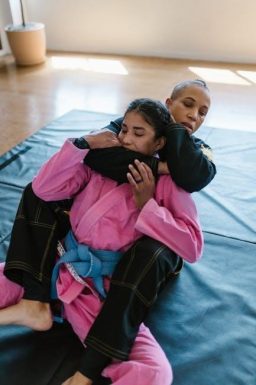A proper BJJ Gi fit is essential for comfort, performance, and compliance with competition rules. This guide helps you navigate size charts, brand differences, and measurement tips to find your perfect Gi.
Importance of Proper Fit in BJJ Gis
A proper fit in a BJJ Gi is crucial for both performance and comfort. A well-fitting Gi ensures optimal mobility, allowing practitioners to execute techniques effectively. If the Gi is too tight, it can restrict movement and cause discomfort, while a loose fit may lead to distractions during training. Proper fit also plays a role in competition rules, as Gis must meet specific regulations to avoid disqualification. Additionally, a Gi that fits correctly enhances training efficiency and overall satisfaction. It’s essential to consider height, weight, and body type when selecting a size, as these factors significantly impact the fit. Many brands offer detailed size charts, including options for men, women, and kids, to help users find their ideal match. By prioritizing proper fit, practitioners can focus on mastering techniques without unnecessary hindrances.
Factors Affecting Gi Size: Height, Weight, and Body Type
Height, weight, and body type are key factors in determining the correct BJJ Gi size. Height is the primary measurement, as it directly affects the length of the jacket and pants. Weight is also crucial, as it influences the fit around the torso and legs. Body type, whether lean, athletic, or stocky, impacts how the Gi sits on the body. For instance, taller individuals may require longer sleeves and pants, while those with broader builds might need a wider cut. Brands often provide charts that correlate height and weight to specific sizes, ensuring a tailored fit. Additionally, some brands offer variations like “L” sizes, which cater to those needing slightly longer inseams. Considering these factors ensures a Gi that is both comfortable and functional, allowing for optimal performance during training and competition.
How Brand Differences Impact Sizing
Brand differences significantly influence BJJ Gi sizing, as each manufacturer may have unique size charts and fits. While height and weight are standard measurements, brands vary in how they interpret these dimensions. Some brands, like Sanabul, offer distinct sizing methods, while others, such as Gold BJJ, provide unisex, women’s, and kids’ cuts with sizes from A0 to A5. Certain brands cater to specific body types, offering slim, athletic, or husky fits. Additionally, some brands include modifications like longer sleeves or wider girths for broader builds. These variations mean that a size A1 in one brand may not fit the same as an A1 in another. This diversity can make choosing the right size challenging, especially for those new to BJJ. Always consult the specific brand’s size chart to ensure the best fit, as their sizing may differ from standard expectations or other brands.
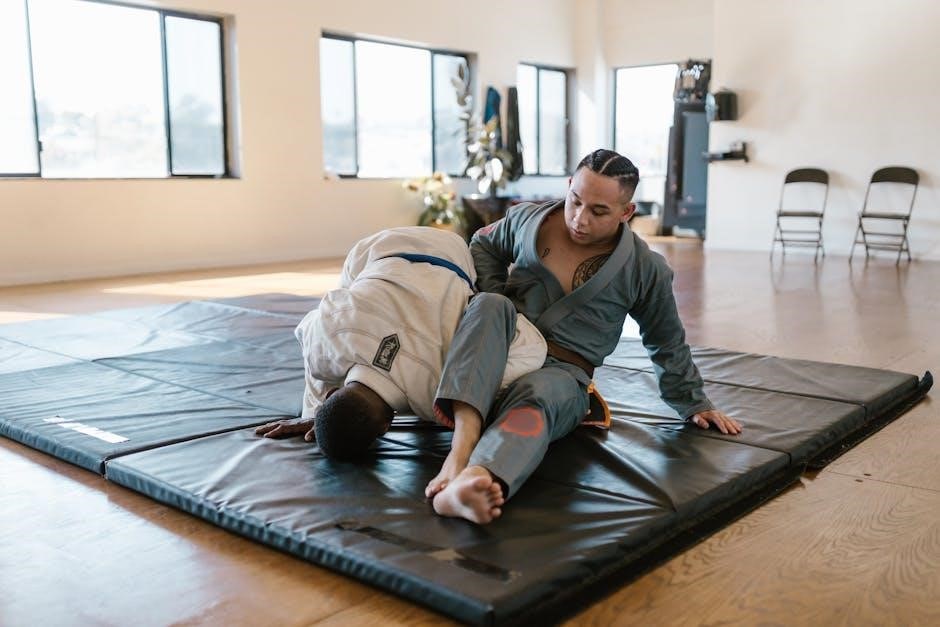
Understanding BJJ Gi Sizing
BJJ Gi sizing is based on standard size ranges (A0-A5) and considers height, weight, and body type. Brands vary slightly, but this guide helps simplify the selection process.
Types of BJJ Gi Sizes: A0 to A5, Men’s, Women’s, and Kids’
Types of BJJ Gi Sizes: A0 to A5, Men’s, Women’s, and Kids
BJJ Gi sizes range from A0 to A5, catering to various heights and weights. Men’s sizes typically accommodate taller and broader frames, while women’s cuts offer a tailored fit for a more ergonomic design. Kids’ sizes are specifically designed for younger practitioners, ensuring comfort and mobility for growing bodies. Each size category is carefully measured to ensure the Gi meets competition standards, from the length of the jacket to the width of the pants. Brands often provide detailed charts to help practitioners choose the right fit based on their specific measurements, ensuring optimal performance during training or competition.
How Different Brands Approach Sizing
BJJ Gi brands vary significantly in their sizing approaches, making it crucial to consult specific size charts for each manufacturer. Some brands, like Sanabul, offer unique sizing methods that differ from standard models, while others, such as Gold BJJ, provide unisex, women’s, and kids’ cuts to cater to diverse needs. Certain brands focus on height and weight ratios, ensuring the Gi meets competition regulations, while others prioritize comfort and mobility through tailored designs. Top Ten, for instance, offers detailed charts based on height and weight, ensuring a precise fit. Each brand’s approach reflects its target audience, whether it’s recreational practitioners or competitive athletes. Understanding these differences is key to selecting the right Gi for your specific requirements.
Role of Weight Classes in Gi Sizing
Weight classes play a pivotal role in determining the appropriate BJJ Gi size, as they help ensure a balanced fit that meets competition standards. Most size charts, such as those from Top Ten and Gold BJJ, list weight ranges alongside height to guide selections. For instance, a competitor weighing between 95-110 lbs might opt for an A00 size, while someone in the 140-165 lbs range could choose an A1. Brands like Sanabul emphasize the importance of cross-referencing both height and weight to avoid sizing errors. This dual approach ensures the Gi is neither too tight nor too loose, promoting optimal mobility and comfort. Ignoring weight classes can lead to improper fits, potentially affecting performance or even disqualification in tournaments. Thus, weight classes are a critical factor in selecting the right Gi for both training and competition.
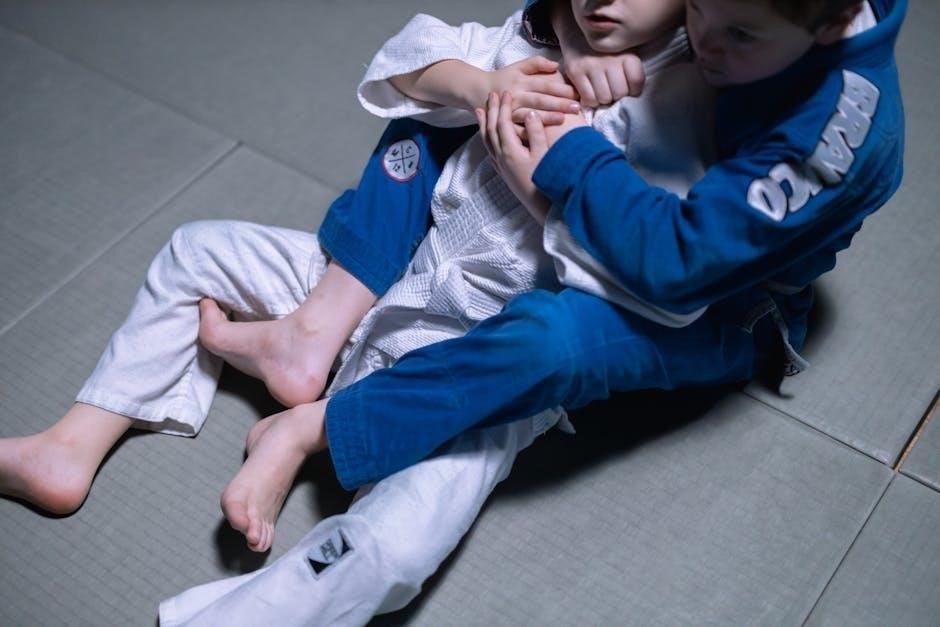
How to Choose the Right Size
Measure yourself accurately, consult size charts, and consider weight classes. Try the Gi on to ensure comfort and mobility, and check brand-specific sizing guidelines for the best fit.
Measuring Yourself for the Perfect Fit
Accurate measurements are crucial for selecting the right BJJ Gi size. Start by measuring your height and weight, as these are primary factors in determining your size. Use a flexible tape measure to record your chest circumference, natural waistline, and the length of your sleeve from the base of the neck to the wrist. Ensure the jacket length reaches your hipbone when standing upright, and sleeves should extend no more than 5 cm beyond your palm when arms are extended. Consider your body type, as some brands offer slim or husky fits. Compare your measurements to the brand’s size chart, as sizing can vary. Double-checking these measurements ensures a comfortable and competition-compliant fit, allowing for optimal mobility during training or competition.
Using BJJ Gi Size Charts Effectively
BJJ Gi size charts are essential tools for ensuring the right fit. Start by identifying your height and weight, as these are the primary factors in determining your size. Locate your measurements on the chart, which typically ranges from A0 to A5 for adults, with additional options for men, women, and kids. Pay attention to the specific brand’s sizing, as variations exist. For example, some brands offer slim or husky fits, catering to different body types. Once you find your size, double-check the measurements for jacket length and sleeve length to ensure compliance with competition standards. Many charts also provide weight classes to help narrow down the best fit. By carefully following the size chart and considering personal measurements, you can select a Gi that offers both comfort and optimal performance.
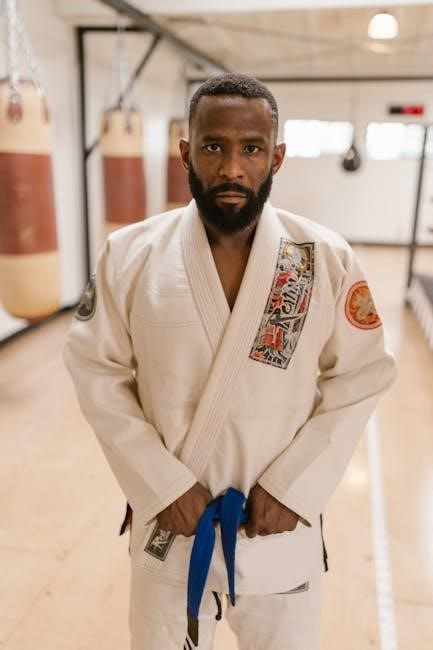
Trying It On: Ensuring Comfort and Mobility
Trying on a BJJ Gi is crucial to ensure it fits comfortably and allows for full mobility. When you put it on, the jacket should reach the top of your hips, and the sleeves should extend just past your wrists when your arms are extended. The pants should fit snugly but not restrict movement. Pay attention to how the material feels—breathable, durable fabrics are ideal for training. Check the collar thickness, as it should provide adequate support without digging into your neck. Move around to test flexibility; the Gi should not feel restrictive during rolls or stretches. If possible, try rolling in it to ensure it stays in place and doesn’t ride up. A proper fit ensures both comfort and performance, making it easier to focus on your training without distractions.
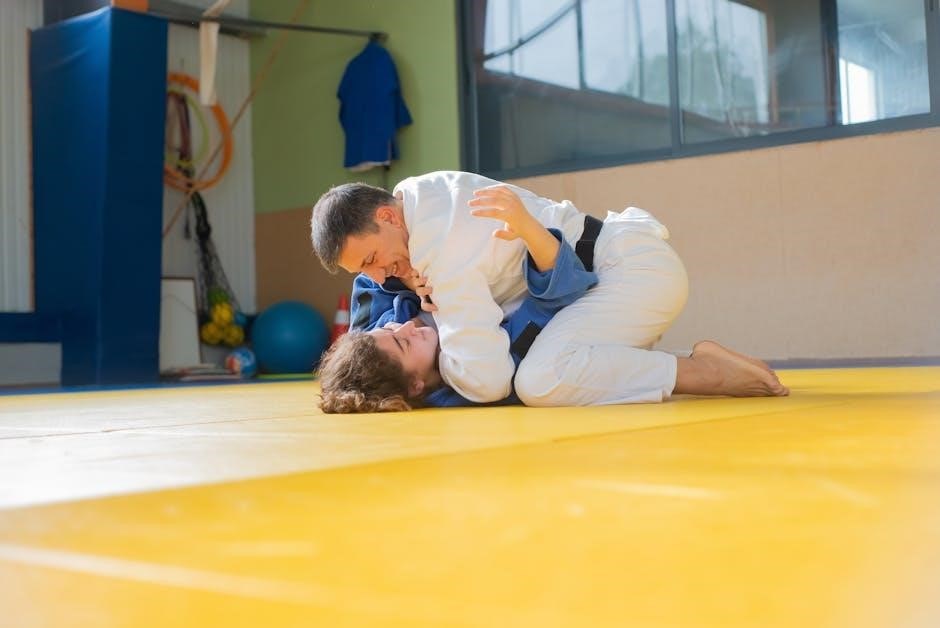
Different Types of BJJ Gis
Explore various BJJ Gi types, including kids’, women’s, and men’s sizes. Each offers unique features for comfort and performance, catering to different practitioner needs and preferences.
Kids’ BJJ Gis: Sizing and Features
Kids’ BJJ Gis are designed to fit growing bodies, with sizes ranging from M0 to M4. These Gis typically cater to children aged 4-14, with weight ranges from 20-45kg. Features include lightweight materials, shorter sleeves, and pants with reinforced knees for durability. Many brands offer size charts that match height and weight to ensure a proper fit. Some Gis feature fun designs and colors to appeal to young practitioners. Proper sizing is crucial for comfort and mobility, ensuring kids can move freely during training. Always refer to the specific brand’s size chart, as measurements can vary. Ensuring the Gi meets competition standards is also important for young competitors. Durable construction and easy-care fabrics make these Gis practical for both training and competition.
Women’s BJJ Gis: Tailored Fits and Sizes
Women’s BJJ Gis are designed to provide a better fit for the female body, with tailored cuts that accommodate narrower shoulders and longer torsos. Sizes typically range from F1 to F5, catering to a variety of body types and preferences. These Gis often feature curved hemlines and sleeves, ensuring a more feminine fit while maintaining functionality. Lightweight materials are commonly used to enhance mobility and comfort during training. Many brands offer women’s-specific lines, with sizes based on height and weight charts. Proper sizing is crucial to avoid restrictions and ensure optimal performance. When choosing a women’s Gi, consider the weave type and weight class to suit your training needs. Always refer to the brand’s size chart for accurate measurements, as sizing can vary between manufacturers. A well-fitted Gi not only improves performance but also boosts confidence on the mat.
Men’s BJJ Gis: Standard and Special Sizes
Men’s BJJ Gis are available in standard sizes A0 to A5, accommodating a wide range of heights and weights. These sizes are designed to fit most body types, with A0 being the smallest and A5 the largest. Special sizes, including long and husky options, cater to taller or broader athletes, ensuring a comfortable fit without sacrificing mobility. Long sizes offer extended pant and sleeve lengths, while husky sizes provide a roomier cut through the chest and shoulders. Many brands also offer unisex cuts, which can be suitable for men with unique measurements. When selecting a size, consider both height and weight to ensure the Gi meets competition regulations. Proper fit is essential for performance, comfort, and durability, making it important to refer to the brand’s specific size chart for accurate measurements. A well-fitted Gi enhances training and competition experience, ensuring maximum mobility and comfort.
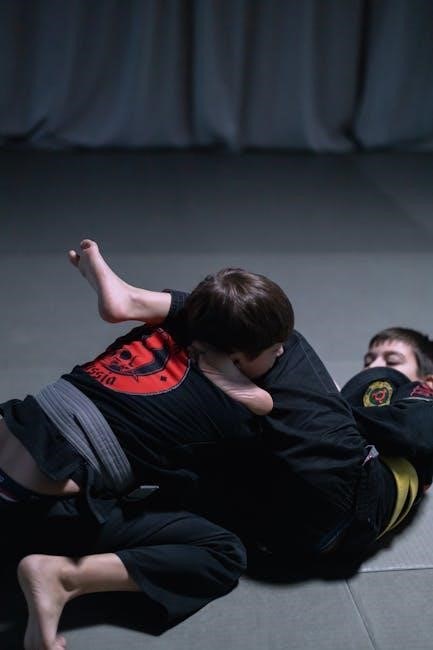
Common Mistakes to Avoid
Ignoring weight classes and measurements can lead to poor fit. Ordering too tight restricts mobility, while too loose may violate competition rules. Always double-check size charts and brand specifics to ensure accuracy and compliance.
Avoiding Sizing Errors
Avoiding Sizing Errors
Avoiding sizing errors is crucial for both performance and compliance; Many practitioners overlook the importance of accurate measurements, leading to gis that are either too tight or too loose. A gi that is too tight can restrict movement and cause discomfort during training or competition, while one that is too loose may not meet regulations set by organizations like the IBJJF. To prevent this, always refer to the specific size chart provided by the brand, as sizing can vary significantly between manufacturers. Measure your height and weight carefully, and consider factors like body type and personal preference for fit. Additionally, be aware of shrinkage, as some gis may shrink slightly after washing. By taking these steps, you can ensure a proper fit that enhances your training experience and avoids potential disqualification in competitions.
Not Ignoring Weight Classes
Weight classes play a crucial role in determining the appropriate BJJ Gi size. Many brands design their gis with specific weight ranges in mind, ensuring optimal fit and comfort. Ignoring weight classes can lead to a gi that is either too tight or too loose, affecting performance and compliance with competition rules. For instance, a practitioner who falls into the A0 size range (60-70 kg) will have different needs compared to someone in the A4 range (90-100 kg). Always cross-reference your weight with the provided size chart to ensure accuracy. Some brands also offer weight-specific cuts, such as “Competitor” or “Heavyweight” designs, catering to different body types and training demands. By considering weight classes, you can avoid sizing errors and select a gi that meets both your needs and regulatory standards, ensuring a balance of mobility, comfort, and durability during training or competition.
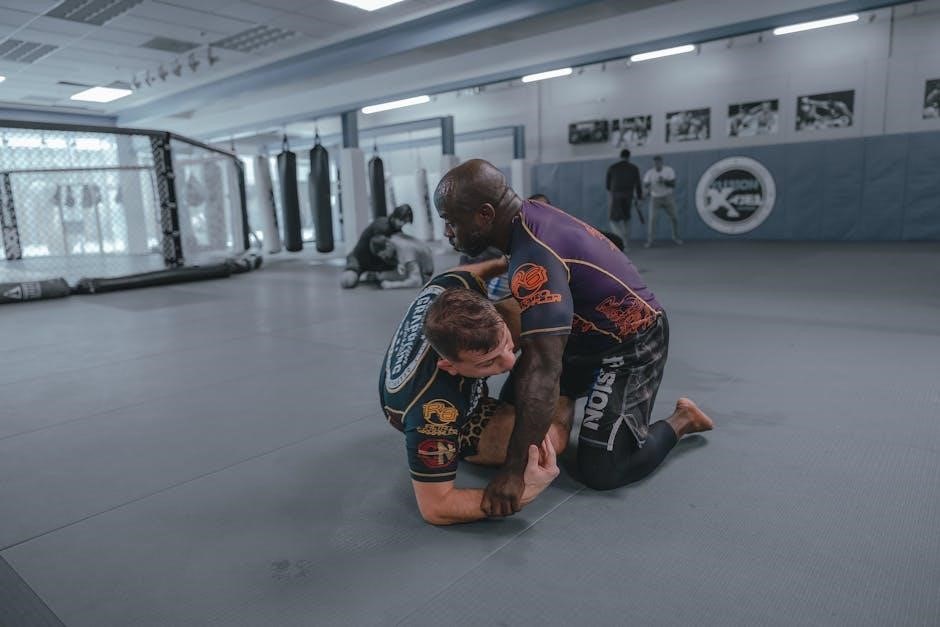
Tight vs. Loose: Finding the Balance
Finding the right balance between a tight and loose gi is essential for optimal performance in BJJ. A gi that is too tight can restrict movement and cause discomfort, while one that is too loose may not stay in place during rolls, potentially leading to penalties in competition. The ideal fit allows for a full range of motion while maintaining proper coverage. Ensure the jacket reaches your hips and the sleeves extend just past your wrists when arms are extended. Pants should fit securely around the waist without being overly restrictive. Many brands offer tailored cuts, such as slim or standard fits, catering to different preferences and body types. By carefully reviewing size charts and trying on the gi before purchase, you can achieve the perfect balance between comfort and functionality, ensuring peak performance on the mat.
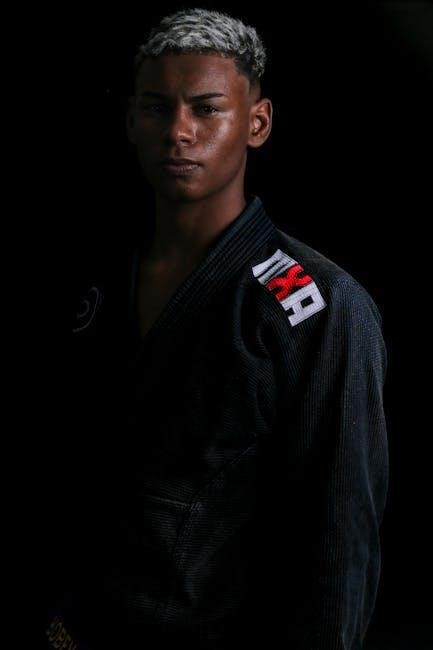
Technical Aspects of BJJ Gis
BJJ Gis are crafted from durable materials like cotton, with weaves ranging from light to heavy. They must meet competition regulations, ensuring proper fit, color, and patch placement for both functionality and style.
Material and Weave Types
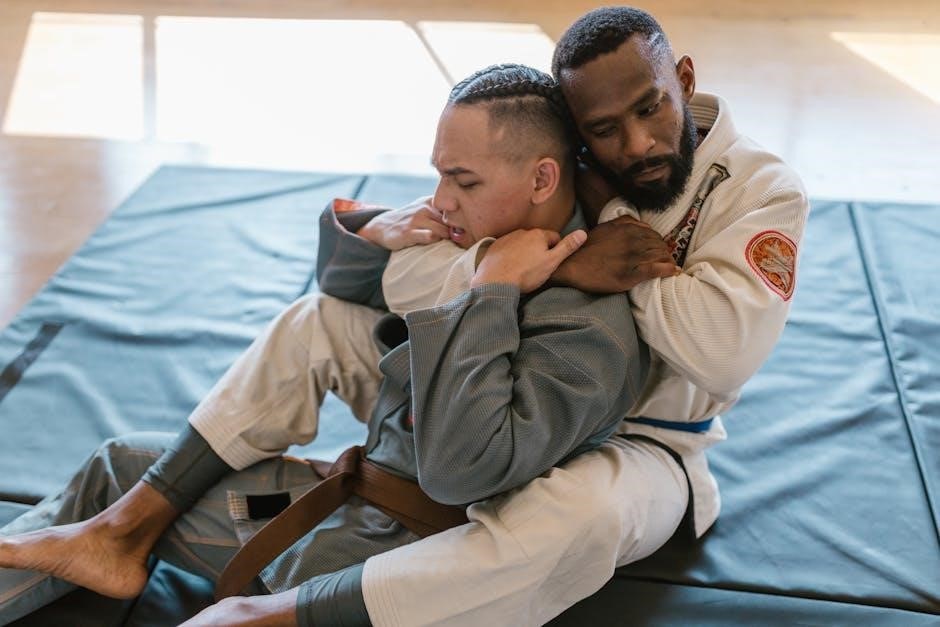
BJJ Gis are primarily made from cotton, with varying weave types that affect durability and comfort. The most common weaves are single, double, and gold. Single weave Gis are lightweight and breathable, ideal for training in warmer climates or for lighter practitioners. Double weave Gis offer increased durability and are often preferred for heavy training or competitions. Gold weave strikes a balance between weight and strength, providing both comfort and longevity. Some brands also offer hybrid weaves, combining different materials for unique performance characteristics. The choice of material and weave type depends on personal preference, training intensity, and weight class. Proper material selection ensures optimal performance and comfort during rolls and matches.
Color Regulations in Competitions
BJJ Gi color regulations are strict in competitions to maintain uniformity and fairness. Most organizations, like the IBJJF, allow only white, black, or blue Gis. The color must be solid, with no bright patterns or neon accents.
Patches and embroidery must comply with size and placement rules to avoid disqualification. The collar and belt must contrast with the Gi’s primary color.
Some events permit special colors for unique occasions, but standard competitions adhere to these guidelines. Always check the specific tournament rules to ensure compliance and avoid penalties.
Patches and Embroidery Placement
Patches and embroidery on BJJ Gis are not just for aesthetics; they often represent affiliations, sponsors, or personal style. However, their placement is regulated, especially in competitions.
Typically, patches are placed on the sleeves, back, and pants, while embroidery is common on the collar, hem, or belt. Competition rules may restrict the size and number of patches to maintain a clean, professional appearance.
Some organizations specify that patches must be smaller than a standard size and placed in designated areas to avoid covering important parts of the Gi. Always check the rules before adding custom designs to ensure compliance.
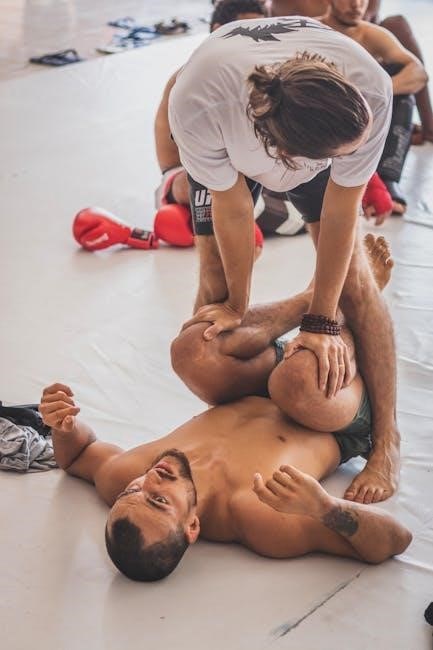
Caring for Your BJJ Gi
Proper care extends your Gi’s lifespan. Wash in cold water, avoid fabric softeners, and air-dry to prevent shrinkage. Regular maintenance ensures durability and hygiene for optimal performance.
Washing and Drying Tips
Proper washing and drying are crucial for maintaining your BJJ Gi. Start by washing it in cold water with a mild detergent to prevent fabric damage and shrinkage. Avoid using fabric softeners or bleach, as they can weaken the material and affect the Gi’s texture. After washing, gently remove excess water without wringing the fabric. Air-drying is highly recommended to prevent shrinkage and extend the Gi’s lifespan. Hang the Gi in a well-ventilated area, away from direct sunlight. If machine drying is necessary, use a low heat setting. Regular cleaning keeps your Gi hygienic and ensures optimal performance during training or competitions. Proper care not only maintains the Gi’s quality but also enhances its durability, making it a long-lasting essential for your BJJ journey.
Preventing Shrinkage
Preventing shrinkage is vital to maintain your BJJ Gi’s fit and longevity. Always wash your Gi in cold water, as hot water can cause significant shrinkage. Avoid machine drying, as high heat can shrink the fabric. Instead, air-dry your Gi by hanging it in a cool, well-ventilated area. If you must use a dryer, select the lowest heat setting and remove it as soon as the cycle ends. Additionally, avoid using bleach or fabric softeners, as they can weaken the material and lead to shrinkage. Proper care ensures your Gi remains comfortable and durable, preserving its quality for years of training and competition. By following these simple steps, you can maintain the perfect fit and extend the life of your BJJ Gi.
Longevity and Maintenance
Ensuring the longevity of your BJJ Gi requires proper care and maintenance. High-quality Gis are made from durable materials, but their lifespan depends on how well you maintain them. Regular washing in cold water with mild detergents helps prevent odor buildup and fabric degradation. Avoid using bleach or fabric softeners, as they can weaken the cotton fibers. Proper storage is also key—hang your Gi to dry and avoid folding it when wet, as this can cause creases and stress on the fabric. Over time, the Gi may naturally shrink slightly, but following care instructions can minimize this. By maintaining your Gi, you ensure it remains comfortable, durable, and hygienic for years of training. Regular maintenance not only extends its lifespan but also preserves its performance and appearance.
Selecting the right BJJ Gi size ensures optimal performance and comfort. Consider fit, brand differences, and maintenance for a perfect choice. Train with confidence and style.
Summarizing the Guide
This guide provides a comprehensive overview of BJJ Gi sizing, emphasizing the importance of proper fit, height, weight, and body type. It explores how brands differ in sizing approaches and the role of weight classes. The guide offers practical advice on measuring yourself, using size charts effectively, and ensuring comfort and mobility. It also covers common mistakes to avoid, such as ignoring weight classes and improper fit. Additionally, it delves into the technical aspects of Gis, including material, color regulations, and embroidery. Caring for your Gi is also addressed, with tips on washing, preventing shrinkage, and maintaining longevity. By following this guide, you can make an informed decision and find the perfect Gi for your training needs.
Next Steps in Choosing Your Gi
After reviewing the guide, the next step is to compare your measurements with size charts from various brands. Consider factors like weight classes and body type to narrow down options. Visit brand websites to check specific sizing details, as some offer unique fits. If possible, try on Gis or read reviews to gauge comfort and durability. Prioritize brands that align with your needs, whether for competition or training. Finally, place your order with confidence, ensuring the best fit for optimal performance on the mat. Remember to follow care tips to extend the life of your Gi and maintain its quality over time.
